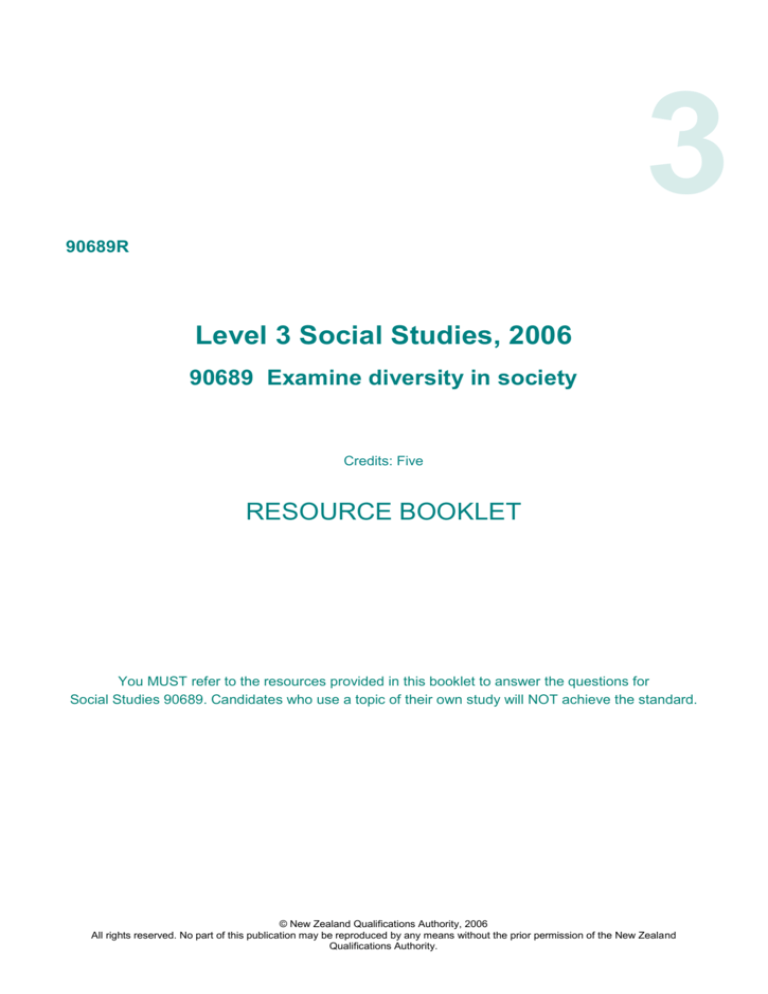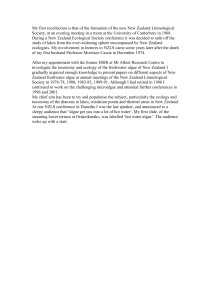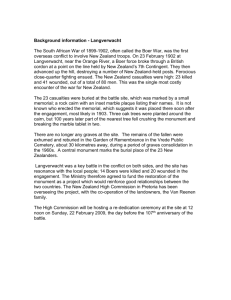
3
90689R
Level 3 Social Studies, 2006
90689 Examine diversity in society
Credits: Five
RESOURCE BOOKLET
You MUST refer to the resources provided in this booklet to answer the questions for
Social Studies 90689. Candidates who use a topic of their own study will NOT achieve the standard.
© New Zealand Qualifications Authority, 2006
All rights reserved. No part of this publication may be reproduced by any means without the prior permission of the New Zealand
Qualifications Authority.
RESOURCE A
‘Ethnic’ means pertaining to, or relating to, a segment of the population within
New Zealand society who share fundamental
•
biological components such as race or colour and ancestry
•
cultural characteristics, including shared values, traditions, customs, language and
religion
•
geographical factors such as nationality or where one was born and tribal affiliations.
Source: (adapted) www.ethnicaffairs.govt.nz
Sources of Intercultural Misunderstanding
[For copyright reasons, this resource cannot be reproduced here. See below.]
Source: (adapted) www.hsc.csu.edu.au/pta/scansw/intcult.html
L3 Social Studies 2006, 90689R – page 2 of 8
RESOURCE B
New Zealand Immigration Policy
There are three streams within the New Zealand Immigration Programme:
The Skilled / Business Migrant Category Policy (60% of the 45 000 places available)
•
Principal applicants under the Skilled Migrant Category are assessed against: health,
character and English language requirements, employability, capacity building
requirements, settlement and contribution requirements.
The Family Sponsored Migrant Category Policy (30% of the 45 000 places available)
•
This category requires applicants to have a family member who is a Resident or Citizen
of New Zealand.
The International / Humanitarian Migrant Category Policy (10% of the 45 000 places
available)
•
This stream is for refugees, and other international (eg Samoan quota) and
humanitarian (eg domestic violence policy) residence applications.
•
New Zealand is a signatory to the 1951 UN Convention Relating to the Status of
Refugees and accepts 750 refugees per year.
Source: (adapted) www.immigration.govt.nz
L3 Social Studies 2006, 90689R – page 3 of 8
RESOURCE C
Migrant Experiences in New Zealand – Pilot Survey Report 2004
Reasons for choosing New Zealand1
1
Total %
Lifestyle in New Zealand
42
Climate and physical environment
32
Educational opportunities
30
Employment opportunities
26
Political freedoms
12
Economic conditions
12
Respondents could provide multiple responses, so proportions add to more than 100%.
Source: (adapted) www.immigration.govt.nz
L3 Social Studies 2006, 90689R – page 4 of 8
RESOURCE D
1.
•
•
•
How have people identified themselves in the 2001 Census?
Increasing ethnic diversity
The count of people of European ethnicity has declined from 83% of the total in the
1991 Census to 80% in 2001.
The census counted more people of Asian ethnicity than Pacific people’s ethnicity.
–
Counts of people of Asian ethnicity have more than doubled between 1991 and
2001.
The biggest numeric increase in people born overseas since the 1996 census was from
those born in Northeast Asia (China, Japan, South Korea), up 46.4% (28 392 people).
–
30% of recent arrivals from Northeast Asia were in the 15–24 year age group, and
55% of these people said they had participated in a study course in the four weeks
preceding the 2001 Census.
Northeast Asia
Country of Birth
2.
•
•
3.
•
4.
1991
2001
China
9 222
38 949
South Korea
798
17 934
Japan
2 184
8 622
More people born overseas
19.5% of all New Zealand residents were born overseas – up 15.5% since the 1996
–
New Zealand-born population increased by 1.5% over this time period.
50% of the overseas-born population lived in the Auckland Region.
–
12% of the overseas-born population lived in the Wellington Region, and 9%
lived in the Canterbury Region.
More multilingual people
The number of multilingual people increased by 20% from the 1996 Census to 562 113,
or nearly 1 in 6.
–
English is the predominant language spoken.
–
Excluding children under 5 years of age, 1 in 50 people do not speak English.
–
The languages most widely spoken after English were: Māori, Samoan, French,
Yue (Cantonese) and German.
Increase in non-Christian religions
Religion
No. of followers
% increase from 1996
Buddhist
41 634
48%
Hindu
39 798
56%
Muslim
23 631
74%
Source: 2001 Census, Statistics New Zealand
L3 Social Studies 2006, 90689R – page 5 of 8
C
RESOURCE E
In 2004, some residents of New Zealand’s 12 largest cities were asked about cultural
diversity and whether this diversity has made their city a better or worse place to live.
Perception of impact on city of greater cultural diversity
[For copyright reasons, this resource cannot be reproduced here. See below.]
Most frequently mentioned reasons why greater cultural diversity has had a positive impact
on city (% national level)
[For copyright reasons, this resource cannot be reproduced here. See below.]
Most frequently mentioned reasons why greater cultural diversity
has had a negative impact on city (% national level)
[For copyright reasons, this resource cannot be reproduced here. See below.]
Source: (adapted) www.bigcities.govt.nz/surveys.htm
L3 Social Studies 2006, 90689R – page 6 of 8
RESOURCE F
Race Relations Day on March 21: Together We Grow:
Te Ranga Tahi
The poster symbolising this theme, designed by a young Asian New Zealander, is a familiar New
Zealand fern, but with a diversity of fronds …
[For copyright reasons, this resource cannot be reproduced here. See below.]
Source: Address by Joris de Bres, Race Relations Commissioner – 5 March 2005.
Diwali (30 October, 2005) is perhaps the most important and ancient of the Indian festivals …
[For copyright reasons, this resource cannot be reproduced here. See below.]
Mātāriki is a month-long festival that acknowledges and celebrates the Māori new year (tau hou)
…
[For copyright reasons, this resource cannot be reproduced here. See below.]
Pasifika attracts people from throughout the Auckland Region and New Zealand …
[For copyright reasons, this resource cannot be reproduced here. See below.]
The Auckland Lantern Festival is organised and sponsored by Auckland City in partnership
with the Asia New Zealand Foundation …
[For copyright reasons, this resource cannot be reproduced here. See below.]
Source: (adapted) www.aucklandcity.govt.nz/whatson/events/
L3 Social Studies 2006, 90689R – page 7 of 8
RESOURCE G
Hundreds march for interfaith harmony
[For copyright reasons, this resource cannot be reproduced here. See below.]
Source: (adapted) Errol Kiong and Derek Cheng, The New Zealand Herald, 25 July 2005.
Rally celebrates ethnic diversity, condemns racism
[For copyright reasons, this resource cannot be reproduced here. See below.]
Source: (adapted) NZPA, The New Zealand Herald, 24 August 2004.
Hiring immigrants pays for supermarket
[For copyright reasons, this resource cannot be reproduced here. See below.]
Source: (adapted) Simon Collins, The New Zealand Herald, 2 September 2005.
Immigrants bring new take on life, and death
[For copyright reasons, this resource cannot be reproduced here. See below.]
Source: (adapted) Julie Middleton, The New Zealand Herald, 19 October 2005.
My Home Now: Migrants and refugees to New Zealand tell their stories
Review of My Home Now: Migrants and refugees to New Zealand tell their stories
edited by Gail Thomas and Leanne Mackenzie
[For copyright reasons, this resource cannot be reproduced here. See below.]
Source: (adapted) Julie Middleton, The New Zealand Herald, 6 January 2006.
L3 Social Studies 2006, 90689R – page 8 of 8








